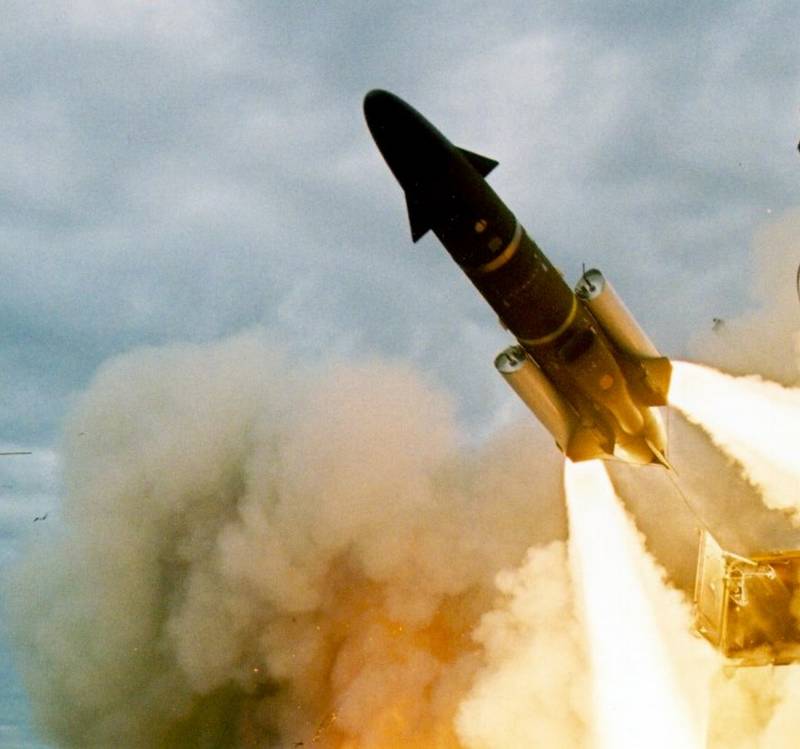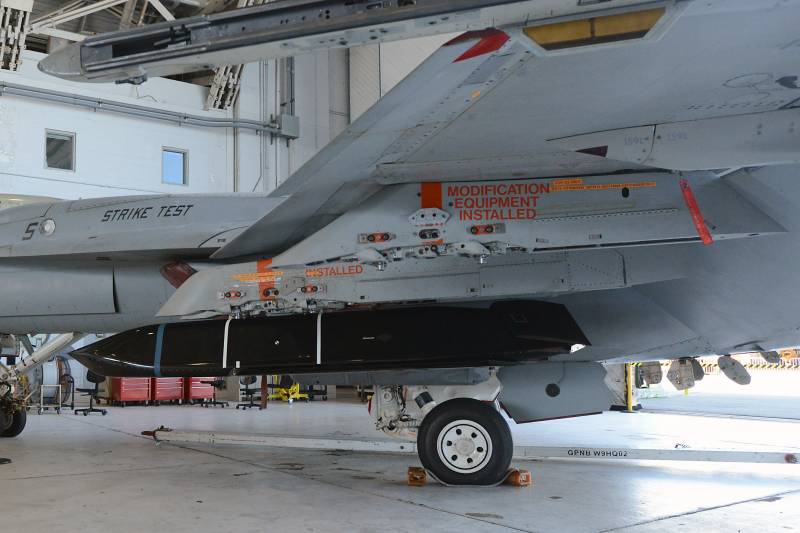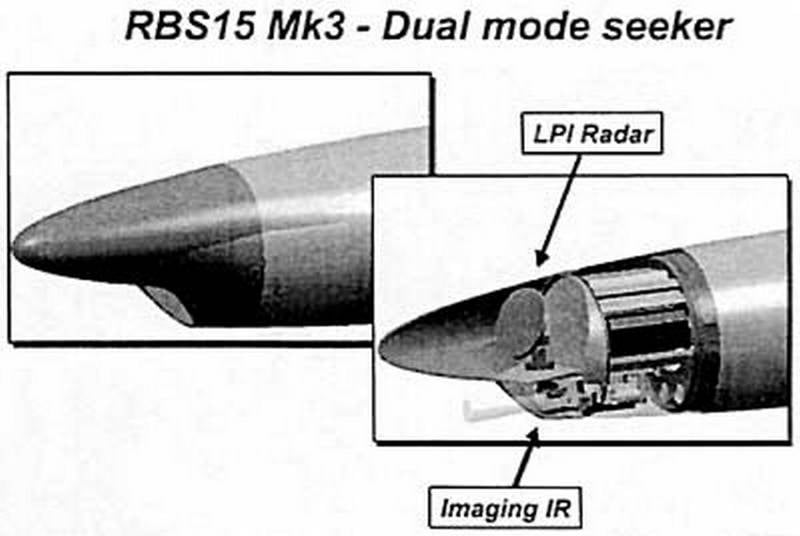A multi-purpose version of the Swedish anti-ship missile RBS-15 will appear in the list of the main threats on Russia's western frontiers.
The role of modern high-precision rocket weapons in the network-centric wars of the late twentieth and early twenty-first centuries, it could no longer be challenged after the American and Soviet strategic cruise missiles of the BGM-109 “Tomahawk” and X-55 families entered service. During Operation Storm in the Desert, the unique capabilities of the Tomahawks in the low-altitude breakthrough of Iraqi air defense systems of the first and second generations (C-75, С-125 and С-200) were confirmed in combat conditions. single-channel and did not have the technical capabilities of tracking and “capturing” air targets at altitudes less than 300 — 500 meters. With mixed success, the BGM-109C / D was intercepted only by Osa-AK self-propelled anti-aircraft missile systems and, even more rarely, the Shilka ZSU-23-4. True, they couldn’t bring much contribution to the missile defense of Iraq’s strategic facilities because of the short range in 10 km (the trajectories of only a small number of Tomahawks fell within the range of the Osa-AK complexes).
Later, 6-channel medium-range and long-range anti-aircraft missiles C-300PT / PS / PMU-1 / 2 began to come into service with many of the Allied states of Russia. The use of multifunctional radar with PFAR 30H6E, low-altitude detectors 76H6 and semi-active radar guidance of 5ВХNUMXРР / 55НХNUMXЕ missiles in combination with the new algorithms for processing radar information many times reduced the combat potential of the APs, which we have found and after, we did it, we did it, and we did it, and we did it, and we didn’t take it. Armed with BGM-48, they began to look for new ways to eliminate the emerging technical gap. The most ambitious program that later surpassed all expectations was JASSM (“Joint Air to Surface Standoff Missile”). Work on a promising long-range tactical cruise missile started at the end of the 6s. The focus was on reducing the radar signature of a promising means of air attack, and therefore most of the hull was made of composite and radio absorbing materials. The corpus itself is represented by longitudinal ribs (the rocket has a trapezoidal section), which contribute to the scattering of electromagnetic radiation from the enemy's radar. According to preliminary information, the calculated EPR AGM-109A can be 90 — 158 m0,07, which is approximately comparable to the radar signature of the X-NUMX-generation F-0,1A “Raptor” fighter. Moreover, the flight of these missiles can take place at an altitude of 2 — 5 m, which reduces the range of confident detection and tracking to 22 — 20 km even by three-hundredth radars placed on 40B38 universal towers.
Also, due to the equipment of modern self-propelled anti-aircraft missile systems with multi-band optical-electronic sighting scopes based on the latest generation TV / IR matrices, Lockheed Martin specialists paid special attention to the configuration of the Teledyne CAE J402 turbojet engine nozzle: its slice, which means and the inner surface is directed to the upper hemisphere, so that the infrared sightings attached to the enemy's FIRM “do not see” the hottest part of the nozzle. and the JASSM direction finding is reduced.
The sale of a modernized version of AGM-158B JASSM-ER missiles to the Polish Air Force poses a fairly large threat, sometimes surpassing Tomahawks, for the Russian Armed Forces in the European part. Their range has been increased from 500 to 960 — 1300 km (according to various estimates). When launched from the Polish, Ukrainian or Lithuanian airspace, JASSM-ER can reach many of our strategic facilities near Orenburg, Kazan and Nizhny Novgorod, while the procedure for intercepting them is several times more complicated than “hunting” for more visible in all spectra "Tomahawks." At the moment, the Polish Air Force receives batches of AGM-158A JASSM missiles with a standard range of 370 — 500 km, which pose a potential threat only to military targets in the Leningrad, Pskov and Smolensk regions (as part of the first half-billion contract on the Foreign Military Sale line, the Poles will be supplied with 40 missiles of this modification). Later, for the arming of the Polish F-16C Block 52 +, deliveries of super-long-range variants of JASSM-ER will begin; This contract is already more significant, including the AGM-70B 158 missiles. And this indicates that the US is preparing its Eastern European henchmen for a serious confrontation with Russia, whose plans are far from simple local escalation in the Baltic or over the Black Sea.
RBS-15MK4: TURNING FROM A CONVENTIONAL ANTI-SCRAPTED ROCKET TO SOUND-HIGH-ACCURATE super-long-range weapons. DRIVE AND OVERCOME AMERICAN JASSM-ER AND LRASM
As we managed to find out, the American JASSM-ER ultra-long-range tactical missile confidently occupied its niche in the western market of precision weapons. The placement of a heavy concrete-piercing warhead J-1000 capable of hitting well-protected enemy “oporniks” with a 2-meter reinforced concrete dimension and a 15-meter ground dimension, in addition to a range of 1300, makes this rocket a more preferable option than the KEPD-350 Taurus missile launcher »With a range of only 500 km. JASSM-ER also has an anti-ship version under the index AGM-158C LRASM-A / B. LRASM-A is designed to launch from the suspensions of strategic bombers and tactical bombers aviationThe LRASM-B is launched from the Mk 41 VLS Universal Deck Mount Integrated Launchers. Today, LRASM is the longest-range stealth RCC in the world, ahead of the more visible anti-ship versions of the BGM-109B / E Tomahawk (550 km) in the RL / IR bands. Now the aviation version of the ASM AGM-158C LRASM-A is actively “running” from the deck of the F / A-18E / F Super Hornet fighter, which indicates its adoption by the American fleet in 2018-2019 The rearmament of American carrier-based aircraft from Harpunov to AGM-158C will lead to an increase in the radius of the anti-ship defense of aircraft carrier attack groups from 1500 to 2000 km.
The JASSM-ER family, handed out "left and right" by the air forces of Finland and Poland, is not the only threat on the European theater of operations, in the coming years it will also add deeply modernized Swedish anti-ship missiles of the RBS-15 family. The first version of the rocket RBS-15F (Mk1), developed and adopted by the Swedish Air Force in the late 80-s. last century, was intended to hit naval targets at a distance of 90 km. It was equipped with an active radar GPS from Philips, operating in the Ku-band with an azimuthal viewing area of 60º and an elevation 30º. Also, on the basis of this version, the anti-ship anti-ship complex RBS-15Ka with a radius of 100 km was developed by Saab Missiles. This modification of the rocket did not differ in multitasking, and in terms of range it was inferior to most of the modern RCC at that time, including the RGM-84F with a range of 315 km. Nevertheless, the program continued to evolve, so that a modification of RBS-97Mk15 appeared in 2, and RBS-2004Mk15 in 3.
The latest version of the RPC received on 26% more tyagovity French turbojet «Microturbo TRI60-5» (c thrust against 448 357 kg at options «Microturbo TRI60-1», installed on the RBS-15Mk1) single-shaft type with a three-stage axial compressor. To control the operating modes of the TRI60-5 engine, a digital module ECU (“Electronic Control Unit”) was introduced, which controls the speed and fuel consumption, which in addition to a larger fuel tank and higher density fuel allowed the RBS-15Mk3 rocket to reach 200 range km An important technological innovation of the TRI60-5 is that the thrust vector deflection system is equipped with a rotary nozzle unit. Due to this subsonic CRP can realize anti-aircraft maneuvers with overloads of about 10 units. With the nose aerodynamic controls alone, high maneuverability would be impossible. Despite the fact that RBS-15Mk3 has a normal ogival longitudinal section of a hull with a diameter of 0,5 m, its radar signature is reduced to approximately 0,1 — 0,15 м2 due to the incorporation of a large number of radio-absorbing elements into the design, as well as the ARGSN antenna tilt control system. When approaching a surface ship equipped with modern anti-aircraft missile systems, the AR web turns in the direction of the upper hemisphere, which several times reduces the effective scattering surface of the RBS-15Mk3. In terms of range, this version of the Swedish anti-ship missile surpasses the first versions of the X-35 and Harpoon anti-ship missiles, but is inferior to the modern X-35 (260 km) and AGM / RGM-84D (220 km). In terms of its ability to overcome the ship's missile defense system, the RBS-15Mk3 is superior to the modern versions of the American and Russian "Uranus" and "Harpoons".
Although these missile versions do not belong to the flagship category of high-precision weapons of the XXI century, the Swedish "Saab AB" did not stop there. Back in 2008, information appeared on foreign resources about the development of a fundamentally new version of the RBS-15Mk4 rocket. This project provides for: deep modernization of the airframe, integration of an additional infrared homing channel, a new multi-band radio correction system both through satellite channels and through communication channels with the carrier and friendly aviation complexes, as well as a more efficient on-board computer. It is reported that the range of the RBS-15Mk4 (RBS-15F-ER) can be increased to 1000 km, and therefore the volume of the fuel system and the dimensions of the rocket will increase. According to a recent publication by Jane's Defense Weekly, citing a Saab AB spokesman, the new missile will be based on a new economical turbojet engine and a hull with a large presence of composite materials.
The application of the new processor is explained not only by the installation of a more advanced engine, but also by the use of additional algorithms for the independent search for remote surface objects in the inertial navigation system. A similar technique was also used by Lockheed Martin developers when programming the LRASM inertial rocket system. The fact is that a flight over a distance of 500 and more kilometers involves a situation where there is a significant shift in the coordinates of the moving surface target ship. As long as the subsonic LRASM or RBS-15Mk4 gets to the initial position of the enemy warship in 800 km from the launch point (it will take 50 — 55 minutes), it can shift by 45 — 50 km in any direction. If at this moment the rocket will act autonomously (without third-party target designation and correction), there is a chance to simply lose it due to the exhaustion of jet fuel.
To avoid this, long-range tactical missiles are equipped with a more powerful autopilot control processor, which is loaded with numerous configurations of target search trajectories, which has gone beyond the calculated location. The most common maneuver is the “snake”: the rocket smoothly changes course in the azimuthal plane, while simultaneously scanning surface space for the presence of a “lost” target. Together with the "snake" can be "slide"; This maneuver can help detect an enemy ship that has gone beyond the limits of the radio horizon. For the first time, such methods of autonomous search for targets were embodied in the autopilot software of our Amethyst P-70, Bazalt P-500 and Granit P-700 PCR, as well as in the American maritime Tomahawk - BGM-109B TASM. Similar algorithms for finding targets will be inherent in the new Swedish rocket RBS-15Mk4.
Due to the additional installation of an infrared homing head, the range of tasks for the rocket will be expanded. In particular, the RBS-15Mk4 can be used to destroy warm-contrast and radio-contrast ground targets, including moving objects with an accuracy of 2 — 5 m. It should be noted that this combined homing head was also developed for the current modification of the RBS-15Mk3. Its nasal module is represented by a kind of radiotransparent “shark nose” type fairing, under which there is a heat-transparent part of the infrared HOS fairing made of a certain type of spinel ceramics.
Improving the tactical and technical parameters of the “Mk4” will be reflected in an additional decrease in its radar visibility. Firstly, an even greater percentage of radio absorbing materials will be used in the body of the product. Secondly, in the structure or on the inner surface of the radio transparent fairing of the homing head, specialized uncontrollable screens made of frequency-selective materials / surfaces (CHIP) can be placed, represented by a photoelectron-corrected film or a mesh grid.
Such screens will be optimized only for the working frequency of the millimeter-wave range of the GOS of the rocket, centimeters electromagnetic waves, on which most of the radars of the naval anti-aircraft missile systems operate, will be absorbed, re-reflected and attenuated inside the fairing, or reflected with a large scatter in the case of perforated screen foil with a high degree of electrical conductivity. Tests with a frequency-selective “cap” screen on the basis of a perforated surface were carried out to demonstrate the reduction of the EPR slot antenna array (AAR), which today represent the majority of ARGSN various classes of missiles, including the X-35 anti-ship missile. As a result, the 2-fold reduction in the ESR was achieved with a slight loss of the energy capabilities of the antenna's working wave. And this is only a small part of the fact that in the future it can be used to reduce the EPR of active radar homing heads of various precision weapons, including the RBS-15Mk4.
The upgrade of the Swedish RBS-15Mk3 PKR to the level of the multi-purpose Mk4 takes place as part of the 359-million contract between the Swedish Defense Procurement Agency (Försvarets Materielverk) and the Saab AB group. It is known that the missiles will be fully unified with the weapons control systems of the inconspicuous Visby class corvettes (product index RB-15Mk3 +), the 4 ++ JAS-39NG generation multipurpose fighter jets (RB-15F-ER index, - Extanded Range ) and coastal SCRC, and adoption is expected after 2026-th year. The RBS-15Mk4 will be only slightly inferior to the United States JASSM-ER and LRASM in the range, as well as the indicators of radar and infrared stealth. As for multi-tasking and highly mobile missile defense capabilities, the Swedish concept looks much more sophisticated and more dangerous than any existing subsonic European-launched cruise missile. Accordingly, it is time to think about countermeasures to be taken in response to the new rocket "fist" in the Northern European operational direction.
Information sources:
http://forum.militaryparitet.com/viewtopic.php?id=16415
http://rbase.new-factoria.ru/missile/wobb/rbs15mk3/rbs15mk3.shtml
http://rbase.new-factoria.ru/missile/wobb/agm158/agm158.shtml



Information